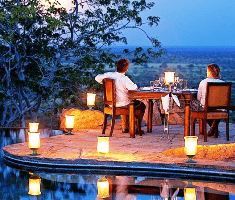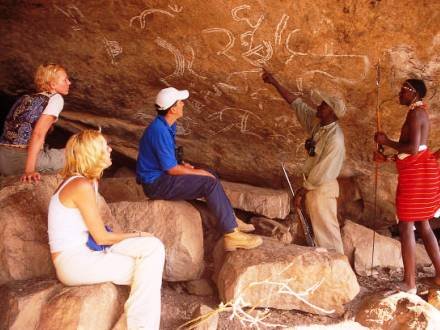 Kenya, a country rich in history and heritage, is an exciting destination for cultural explorers from around the world. For Polish adventurers, the nation's blend of ancient traditions, colonial legacies, and vibrant ethnic cultures offers an unforgettable experience. From coastal cities steeped in Swahili culture to highland communities preserving age-old rituals, Kenya invites visitors to engage deeply with its diverse identity. One of the best ways to start a cultural journey in Kenya is by exploring its UNESCO World Heritage Sites. Lamu Old Town, situated on the northern coast, is a beautifully preserved Swahili settlement characterized by winding alleys, coral stone buildings, and Islamic architecture. It presents a rare chance for Polish travelers to witness a lifestyle shaped over centuries. In Mombasa, Fort Jesus stands as a towering symbol of the country's colonial past. Built by the Portuguese in the 16th century, it reveals stories of trade, war, and resistance. The Sacred Mijikenda Kaya Forests, on the other hand, offer a spiritual dimension with ancient shrines nestled within lush woodlands that still serve as places of worship and ritual. Beyond historic landmarks, the living traditions of Kenya's indigenous communities offer equally compelling experiences. The Maasai people, renowned for their colorful attire and strong warrior culture, welcome visitors into their villages in the Maasai Mara. Here, Polish adventurers can learn traditional dances, participate in storytelling sessions, and gain insight into a lifestyle deeply connected to cattle and nature. In northern Kenya, the Samburu community presents another cultural gem. Known for their intricate beadwork and semi-nomadic ways, the Samburu provide a glimpse into a way of life that remains remarkably intact despite modernization. For those who enjoy cultural immersion through museums and educational centers, Nairobi provides rich opportunities. The Nairobi National Museum showcases exhibits ranging from prehistoric fossils to contemporary art, offering an overview of the country's heritage. The Karen Blixen Museum, set in the farmhouse of the famed Danish author of "Out of Africa," paints a picture of colonial Kenya from a European perspective. Not far from there, the Bomas of Kenya cultural center hosts daily performances and displays of traditional homesteads from various ethnic groups, allowing visitors to travel across Kenya without leaving the capital. From ancient towns to tribal heartlands, Kenya promises a dynamic cultural journey unlike any other in Africa. For Polish adventurers, this East African gem opens the door to immersive experiences that span centuries of human history and culture. Whether walking through the stone alleys of Lamu or witnessing a tribal dance in the Maasai Mara, every moment becomes an enriching story to take home. For those looking to uncover the must-see cultural attractions in Kenya for Polish travelers, the country's living history and vibrant traditions make it a destination like no other. The blend of ancient Swahili heritage, colonial influences, and modern African vibrancy creates a cultural mosaic that captivates at every turn. Travelers can explore spiritual sacred forests, interact with pastoralist communities who still live according to ancestral customs, or learn about Kenya's complex colonial past through thoughtfully curated museum exhibits. Each region offers a distinctive cultural flavor: the coast introduces visitors to Islamic-Swahili traditions; the Rift Valley reveals the strength and color of pastoralist life; while Nairobi provides an urban lens into Kenya's contemporary cultural evolution. From handmade crafts to local music, cuisine, and ceremonial customs, Polish tourists will not just observe but engage directly with Kenya's way of life. This kind of cultural exploration is more than sightseeing it's about connection, appreciation, and broadening one’s worldview through authentic encounters with people and traditions that have endured and thrived for generations.
Kenya, a country rich in history and heritage, is an exciting destination for cultural explorers from around the world. For Polish adventurers, the nation's blend of ancient traditions, colonial legacies, and vibrant ethnic cultures offers an unforgettable experience. From coastal cities steeped in Swahili culture to highland communities preserving age-old rituals, Kenya invites visitors to engage deeply with its diverse identity. One of the best ways to start a cultural journey in Kenya is by exploring its UNESCO World Heritage Sites. Lamu Old Town, situated on the northern coast, is a beautifully preserved Swahili settlement characterized by winding alleys, coral stone buildings, and Islamic architecture. It presents a rare chance for Polish travelers to witness a lifestyle shaped over centuries. In Mombasa, Fort Jesus stands as a towering symbol of the country's colonial past. Built by the Portuguese in the 16th century, it reveals stories of trade, war, and resistance. The Sacred Mijikenda Kaya Forests, on the other hand, offer a spiritual dimension with ancient shrines nestled within lush woodlands that still serve as places of worship and ritual. Beyond historic landmarks, the living traditions of Kenya's indigenous communities offer equally compelling experiences. The Maasai people, renowned for their colorful attire and strong warrior culture, welcome visitors into their villages in the Maasai Mara. Here, Polish adventurers can learn traditional dances, participate in storytelling sessions, and gain insight into a lifestyle deeply connected to cattle and nature. In northern Kenya, the Samburu community presents another cultural gem. Known for their intricate beadwork and semi-nomadic ways, the Samburu provide a glimpse into a way of life that remains remarkably intact despite modernization. For those who enjoy cultural immersion through museums and educational centers, Nairobi provides rich opportunities. The Nairobi National Museum showcases exhibits ranging from prehistoric fossils to contemporary art, offering an overview of the country's heritage. The Karen Blixen Museum, set in the farmhouse of the famed Danish author of "Out of Africa," paints a picture of colonial Kenya from a European perspective. Not far from there, the Bomas of Kenya cultural center hosts daily performances and displays of traditional homesteads from various ethnic groups, allowing visitors to travel across Kenya without leaving the capital. From ancient towns to tribal heartlands, Kenya promises a dynamic cultural journey unlike any other in Africa. For Polish adventurers, this East African gem opens the door to immersive experiences that span centuries of human history and culture. Whether walking through the stone alleys of Lamu or witnessing a tribal dance in the Maasai Mara, every moment becomes an enriching story to take home. For those looking to uncover the must-see cultural attractions in Kenya for Polish travelers, the country's living history and vibrant traditions make it a destination like no other. The blend of ancient Swahili heritage, colonial influences, and modern African vibrancy creates a cultural mosaic that captivates at every turn. Travelers can explore spiritual sacred forests, interact with pastoralist communities who still live according to ancestral customs, or learn about Kenya's complex colonial past through thoughtfully curated museum exhibits. Each region offers a distinctive cultural flavor: the coast introduces visitors to Islamic-Swahili traditions; the Rift Valley reveals the strength and color of pastoralist life; while Nairobi provides an urban lens into Kenya's contemporary cultural evolution. From handmade crafts to local music, cuisine, and ceremonial customs, Polish tourists will not just observe but engage directly with Kenya's way of life. This kind of cultural exploration is more than sightseeing it's about connection, appreciation, and broadening one’s worldview through authentic encounters with people and traditions that have endured and thrived for generations.
Cultural Highlights in Kenya for Polish Tourists
| Site/Attraction | Location | Cultural Significance |
|---|---|---|
| Lamu Old Town | Lamu Island | Swahili heritage and architecture |
| Fort Jesus | Mombasa | Colonial history and strategic importance |
| Sacred Kaya Forests | Coastal Kenya | Indigenous spirituality and Mijikenda traditions |
| Maasai Mara Villages | Narok County | Traditional Maasai lifestyle and rituals |
| Samburu Cultural Tours | Samburu County | Northern tribal customs and dress |
| Nairobi National Museum | Nairobi | Comprehensive national cultural archive |
| Karen Blixen Museum | Nairobi | Colonial history and literature |
| Bomas of Kenya | Nairobi | Ethnic performances and traditional homesteads |
Discover Kenya's UNESCO World Heritage Sites for Polish Tourists
Kenya's UNESCO World Heritage Sites are gateways to understanding the nation’s storied past and diverse cultural identity. These sites capture the imagination of travelers who seek more than just scenery they want to connect with history, traditions, and the communities that have shaped the country for centuries. For Polish tourists with a thirst for heritage, few places are as rewarding as the coastal and inland wonders of Kenya. Among the most iconic destinations is Lamu Old Town, located along the Kenya coast. This ancient Swahili settlement is a living museum of Islamic architecture, coral stone houses, and narrow, winding streets where donkeys still serve as the primary mode of transport. The town's enduring charm lies in its daily rhythm, religious devotion, and the centuries-old trade legacy that connected Africa to Arabia and Asia. It is an essential part of the Kenya coast cultural heritage for Polish travelers. Farther south in Mombasa stands Fort Jesus, a dramatic 16th-century fort built by the Portuguese. Over time, it has changed hands among Arab, British, and Omani rulers, each leaving an imprint on its walls and surroundings. The museum inside narrates the fort’s turbulent history and its significance in protecting and contesting maritime trade. Not to be overlooked are the Sacred Mijikenda Kaya Forests, found in the coastal hinterlands. These forests house hidden shrines that continue to serve as spiritual hubs for the Mijikenda people. They are places of prayer, initiation, and ancestral memory, protected by local councils and celebrated for their ecological and cultural value. Each of these UNESCO sites offers more than historical insight they provide immersive cultural experiences. Visitors can interact with local communities, attend festivals, and explore markets filled with Swahili crafts and coastal cuisine. For Polish travelers interested in the deeper narratives of a destination, these heritage sites provide the perfect blend of authenticity and education. By exploring Kenya's UNESCO treasures, Polish tourists do more than visit a new country; they walk through centuries of global interaction, religious tradition, and African resilience. Whether strolling through a centuries-old fort or walking the peaceful forest paths of the Mijikenda, they are offered a rich, unforgettable connection to Kenya’s vibrant soul. These heritage sites are not just monuments frozen in time but living cultural ecosystems that continue to shape the identity of local communities. Each visit offers a personal journey into Kenya's layered history, where stories of trade, conquest, resistance, and spirituality unfold in authentic settings. Polish visitors can witness ancient Swahili customs still practiced in Lamu, explore the strategic significance of Fort Jesus through its well-preserved architecture and exhibits, or reflect on indigenous spirituality in the Kaya Forests, where nature and belief are intertwined. These interactions foster a deep respect for Kenya’s cultural complexity. Such experiences provide more than memories they inspire appreciation for the resilience and creativity of the Kenyan people. They also strengthen intercultural understanding, helping Polish travelers see global heritage through new eyes. Kenya’s UNESCO sites are not only a celebration of the past, but a bridge to meaningful, present-day cultural exchange.
What Are the Best UNESCO Heritage Sites in Kenya to Visit?
Kenya's UNESCO World Heritage Sites represent some of the most captivating and meaningful destinations for travelers who want to connect deeply with history and culture. For Polish backpackers, these sites are not only scenic but also provide direct access to local traditions, stories, and spirituality that define Kenya's diverse identity. These cultural landmarks are scattered across the country and offer a unique mix of colonial, Swahili, and indigenous narratives.
- Lamu Old Town: This Swahili coastal town is a living testament to centuries of Islamic influence and African heritage. Backpackers can explore its narrow, maze-like streets, admire coral-stone homes with intricately carved doors, and observe the continued use of donkeys for transport. The town’s architecture, local mosques, and vibrant marketplaces offer an authentic look into a culture that has remained largely untouched by modernity.
- Fort Jesus in Mombasa: Constructed by the Portuguese in the late 1500s, this imposing fortress has witnessed waves of conflict and change, having passed through the hands of Arab, British, and Omani rulers. Inside, visitors can view artifacts, ancient cannons, and informative exhibits that chart the history of maritime trade and colonial rivalry in East Africa.
- Sacred Mijikenda Kaya Forests: Located along the coast, these sacred groves were once fortified villages and continue to serve as spiritual centers for the Mijikenda communities. These forests are rich in oral history, ancestral traditions, and ecological biodiversity. Guided tours led by community elders provide Polish backpackers with respectful access to these protected spaces.
These sites reflect the depth of cultural heritage sites in Kenya for Polish backpackers seeking more than a typical tourist experience. They offer a chance to walk through living history, listen to ancient stories, and develop a lasting connection to Kenya's multifaceted cultural legacy.
Explore Traditional Maasai and Samburu Culture for Polish Tourists
Kenya's cultural heartbeat is perhaps most vividly felt in the traditions of its indigenous communities, particularly the Maasai and Samburu. These two pastoralist groups, with their striking attire, ancient customs, and profound relationship with nature, offer Polish travelers an immersive and authentic window into East African tribal heritage. For those in search of raw cultural experiences that extend beyond museums and historical landmarks, few opportunities rival the chance to engage directly with these proud and enduring societies. The Maasai Mara is one of the best-known destinations for cultural tourism in Kenya. While the reserve is famed for its wildlife, the surrounding villages are home to the Maasai people, whose customs have endured despite centuries of external influence. Polish travelers can participate in village tours where they are welcomed with traditional chants and dances, observe the construction of "enkangs" (family homesteads), and even learn about age-old rites of passage. Visiting Maasai Mara culture sites for Polish travelers is not just educational; it's a deeply moving cultural exchange that fosters respect and understanding. To the north, the Samburu people inhabit arid regions and are closely related to the Maasai but retain unique customs and dress. Their intricate beadwork, gendered clothing, and ceremonial gatherings are rich with symbolism. Polish adventurers can take part in Samburu-led cultural safaris, where storytelling and community interaction are central. These safaris are often paired with wildlife viewing, making for a balanced journey of nature and culture. Another enriching destination is the Loita Hills, a remote and sacred landscape revered by the Maasai. Here, visitors may witness traditional blessings or spend time with local elders who share oral histories passed down through generations. The hills are not only visually stunning but also spiritually significant, adding depth to any traveler’s itinerary. By engaging with these communities, Polish travelers support sustainable tourism efforts that empower local people to preserve their traditions, languages, and rituals. Their participation provides economic benefits to rural communities while encouraging the continuation of ancestral knowledge that might otherwise fade under the pressures of globalization. These cultural experiences are deeply enriching, offering much more than visual memories. They allow Polish visitors to develop personal connections with community members, whether through storytelling, shared meals, or learning traditional crafts. Every interaction offers an opportunity to understand different worldviews and to appreciate the resilience and ingenuity of Kenya's tribal cultures. The moments spent in these villages go far beyond typical sightseeing. They invite reflection, respect, and a new sense of global empathy. Whether joining in a Samburu dance circle under the stars or listening to a Maasai elder recount tales passed down through generations, travelers are given rare access to living traditions. These exchanges serve not just as highlights of a journey but as building blocks for greater cultural understanding. Local communities benefit from cultural tourism that respects their values and agency, ensuring that traditions are honored rather than exploited. Through responsible travel, bridges are built between worlds, turning tourism into mutual respect and lasting impact.
Where Can Polish Tourists Experience Kenya's Tribal Culture?
Kenya is a land of diverse ethnic communities whose cultural traditions have been passed down for generations. For Polish tourists seeking to go beyond typical tourist routes and embrace a more immersive, people-focused journey, the tribal heartlands of Kenya offer profound experiences. These encounters not only allow visitors to witness ancient customs but also provide opportunities to participate in them, forging a rare and genuine cultural connection. From vibrant dances and colorful attire to sacred rituals and community storytelling, these tribal sites form the foundation of Kenya's living heritage.
- Maasai Mara Village Tours: These guided experiences allow Polish travelers to interact with Maasai warriors, learn about their age-old cattle-rearing practices, and observe traditional dances and ceremonies. Visitors may also explore "enkangs," or family homesteads, offering a firsthand view of Maasai domestic life.
- Samburu Cultural Safaris: Deep in northern Kenya, the Samburu people open their communities to respectful visitors. Known for their intricate beadwork and vibrant dress, the Samburu share their customs, oral traditions, and gender-specific roles through storytelling and ceremonial presentations.
- Loita Hills: A remote and sacred region inhabited by the Maasai, Loita Hills is ideal for Polish tourists seeking spiritual and cultural depth. Here, visitors can join blessing rituals, hear oral histories, and hike through landscapes that hold cultural and ancestral significance.
- Turkana Homesteads: Near Lake Turkana, this semi-nomadic group invites tourists to discover their unique way of life in one of Kenya’s most arid regions. From hut construction to traditional music, the Turkana culture is both resilient and fascinating.
- Pokot Community Visits: Located in Kenya's western highlands, the Pokot people maintain strong traditional beliefs and customs. Visitors can witness age-grade ceremonies, music, and farming rituals that highlight the community's enduring connection to the land.
These immersive activities offer unforgettable insights into Kenya’s indigenous identities, making them vital cultural heritage experiences for Polish tourists seeking authenticity and connection.
Visit Kenya's Cultural Museums and Historical Sites for Polish Tourists
 For Polish tourists with an appreciation for history and culture, Kenya's museums and heritage sites offer a captivating window into the country’s diverse past. From prehistoric discoveries to colonial legacies and indigenous narratives, Kenya's historical destinations are filled with stories waiting to be explored. These locations serve not only as repositories of artifacts but also as interactive learning spaces where visitors can better understand the people, events, and movements that have shaped modern Kenya. Whether you're walking through Nairobi's museums or visiting historic homesteads and cultural centers, you'll find opportunities to connect with Kenya's rich and often complex history. The Nairobi National Museum is a must-visit for anyone wanting a comprehensive overview of Kenya's heritage. Its extensive exhibits range from early human fossils discovered in the Great Rift Valley to ethnographic collections and contemporary Kenyan art. It's an ideal starting point for Polish travelers to ground themselves in the cultural and natural history of the country. The Karen Blixen Museum, housed in the former home of the famed Danish author of "Out of Africa," offers a unique look into colonial-era Kenya from a European settler's perspective. The beautifully maintained home, with its vintage furnishings and lush gardens, brings to life the stories that have fascinated readers around the world. The Bomas of Kenya cultural center provides an immersive experience into the daily lives of various Kenyan ethnic groups. Through traditional music and dance performances, as well as life-size replicas of tribal homesteads, Polish tourists can gain insight into Kenya's ethnic diversity in a single, accessible location. Each of these destinations adds a vital piece to the larger puzzle of Kenya's cultural identity. For those interested in exploring the top historical places in Kenya for Polish tourists, these museums and heritage centers offer both education and inspiration. They provide essential context for the country's dynamic social fabric, illuminating the connections between past and present. In visiting these institutions, Polish tourists support the preservation of Kenyan history and cultural education. They also leave with a deeper understanding of Kenya's resilience and transformation through time. These sites are more than attractions; they are cultural landmarks that connect visitors with Kenya's journey across centuries. Whether you're a history buff or a curious traveler, Kenya's historical and museum sites promise enriching discoveries at every turn.
For Polish tourists with an appreciation for history and culture, Kenya's museums and heritage sites offer a captivating window into the country’s diverse past. From prehistoric discoveries to colonial legacies and indigenous narratives, Kenya's historical destinations are filled with stories waiting to be explored. These locations serve not only as repositories of artifacts but also as interactive learning spaces where visitors can better understand the people, events, and movements that have shaped modern Kenya. Whether you're walking through Nairobi's museums or visiting historic homesteads and cultural centers, you'll find opportunities to connect with Kenya's rich and often complex history. The Nairobi National Museum is a must-visit for anyone wanting a comprehensive overview of Kenya's heritage. Its extensive exhibits range from early human fossils discovered in the Great Rift Valley to ethnographic collections and contemporary Kenyan art. It's an ideal starting point for Polish travelers to ground themselves in the cultural and natural history of the country. The Karen Blixen Museum, housed in the former home of the famed Danish author of "Out of Africa," offers a unique look into colonial-era Kenya from a European settler's perspective. The beautifully maintained home, with its vintage furnishings and lush gardens, brings to life the stories that have fascinated readers around the world. The Bomas of Kenya cultural center provides an immersive experience into the daily lives of various Kenyan ethnic groups. Through traditional music and dance performances, as well as life-size replicas of tribal homesteads, Polish tourists can gain insight into Kenya's ethnic diversity in a single, accessible location. Each of these destinations adds a vital piece to the larger puzzle of Kenya's cultural identity. For those interested in exploring the top historical places in Kenya for Polish tourists, these museums and heritage centers offer both education and inspiration. They provide essential context for the country's dynamic social fabric, illuminating the connections between past and present. In visiting these institutions, Polish tourists support the preservation of Kenyan history and cultural education. They also leave with a deeper understanding of Kenya's resilience and transformation through time. These sites are more than attractions; they are cultural landmarks that connect visitors with Kenya's journey across centuries. Whether you're a history buff or a curious traveler, Kenya's historical and museum sites promise enriching discoveries at every turn.
FAQs About Cultural Tours to Kenya by Tourists from Poland
Kenya offers a vibrant blend of history, tribal traditions, and natural beauty, making it a prime destination for Polish adventurers seeking authentic cultural engagement. From UNESCO heritage sites to remote indigenous villages and colorful festivals, Kenya promises enriching experiences unlike anywhere else. Whether you're exploring ancient Swahili settlements or participating in tribal dances beneath the African sky, cultural travel in Kenya is as transformative as it is memorable. To help you make the most of your journey, here are questions Polish travelers often have about cultural tours in Kenya.
- What Are the Best Places to Experience Local Kenyan Culture? Kenya's most rewarding cultural destinations include Lamu Old Town, Maasai Mara villages, and the Bomas of Kenya in Nairobi. These places offer a rich mix of Swahili heritage, pastoralist traditions, and diverse tribal performances. Each location invites Polish tourists to witness daily life, historical practices, and artistic expression firsthand. From narrow alleys lined with coral-stone houses in Lamu to ceremonial dances in the Maasai Mara, travelers are immersed in Kenya's living traditions.
- Where Can I Interact with Indigenous Communities in Kenya? The best regions for community-based tourism include Narok (Maasai), Samburu County (Samburu), and Turkana. These communities welcome respectful cultural tourists, offering village visits, guided storytelling, and participation in rituals. By joining locally led tours, Polish adventurers can learn directly from tribal elders and artisans, fostering a deeper appreciation of Kenya's indigenous way of life.
- What Cultural Festivals Should I Attend in Kenya? Kenya celebrates numerous cultural festivals throughout the year. The Lamu Cultural Festival showcases Swahili poetry, dhow sailing, and traditional music. The Lake Turkana Festival highlights ethnic diversity with performances from over 14 communities. These festivals are perfect for Polish visitors looking to witness Kenya’s unity through culture, art, and music, and to interact with diverse groups in one lively setting.
- Are There Cultural Museums Worth Visiting in Nairobi? Yes, Nairobi is home to several outstanding cultural museums. The Nairobi National Museum offers a comprehensive overview of Kenya's history, from early human origins to modern art. The Karen Blixen Museum tells the story of colonial-era Kenya, while the Bomas of Kenya hosts live cultural performances and reconstructed tribal homesteads. These museums provide a structured yet interactive entry point into Kenya's rich heritage.
- What Should I Know About Kenyan Cultural Etiquette? Respect and openness go a long way in Kenyan culture. Always ask for permission before taking photos, dress modestly in rural areas, and show interest in local traditions. Learning a few Swahili greetings can help foster goodwill. Polish travelers are encouraged to approach every interaction with curiosity and humility, enriching the cultural exchange on both sides.
- Why Is Cultural Tourism in Kenya Meaningful for Polish Visitors? Cultural tourism in Kenya allows Polish travelers to connect with a heritage that is vastly different yet universally human. Engaging with different worldviews through storytelling, music, cuisine, and rituals promotes empathy and global awareness. Exploring the best Kenyan cultural experiences for Polish adventurers not only deepens their travel experience but also supports the preservation of unique traditions across generations.



